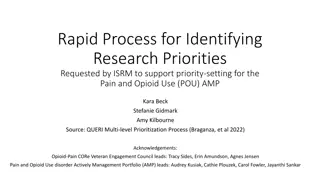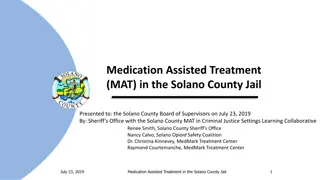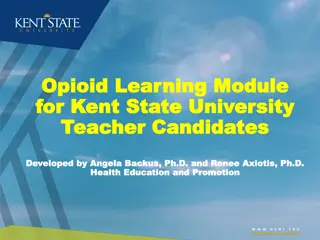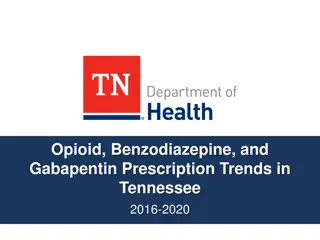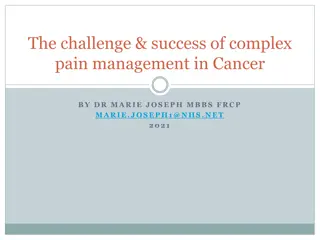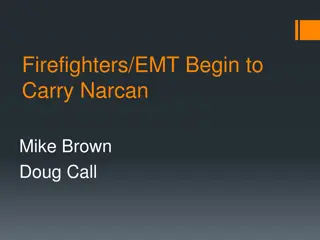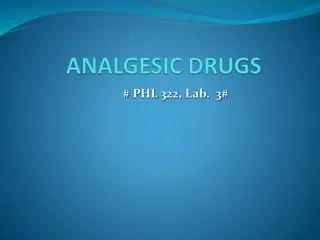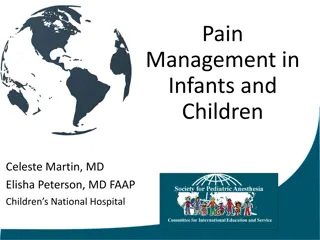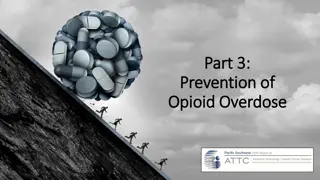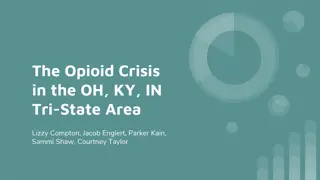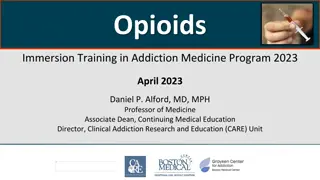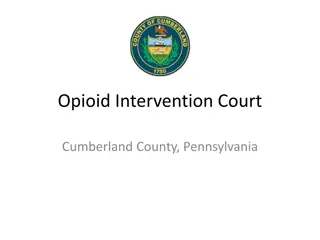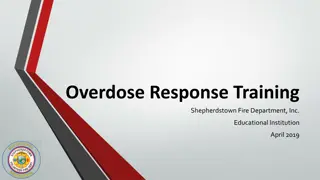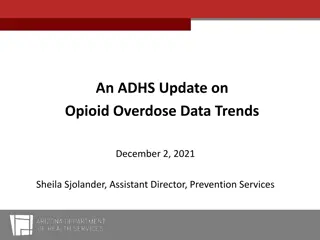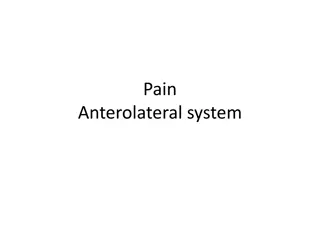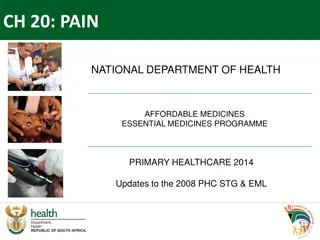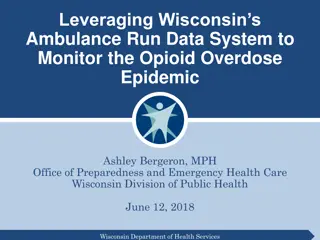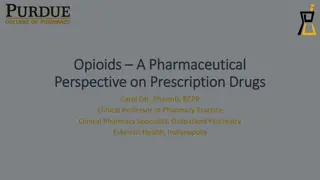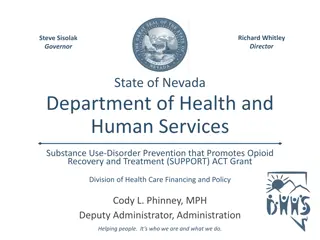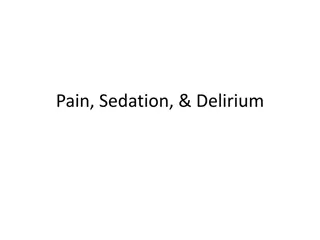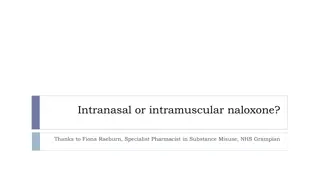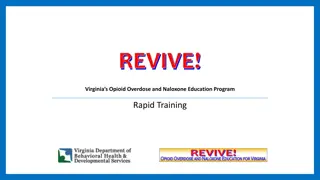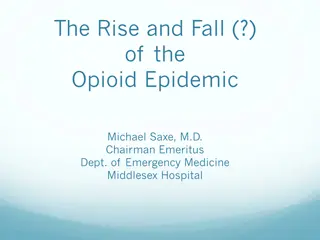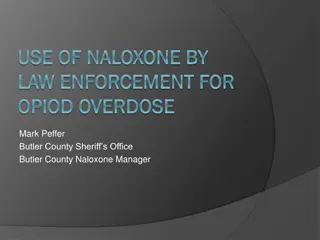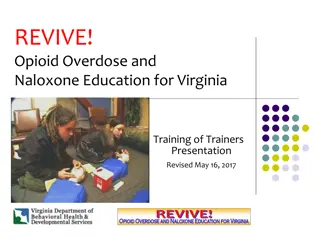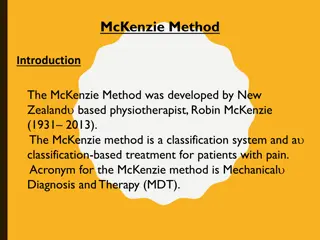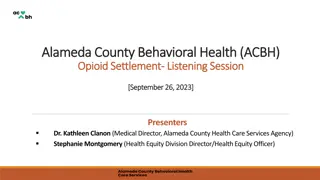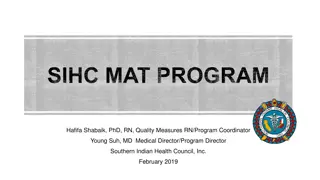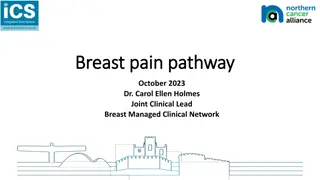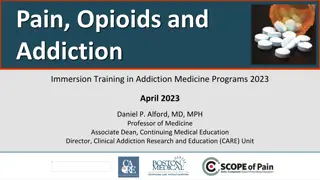Pain Management and Opioid Safety Initiative at Indianapolis VA
This initiative led by Dr. Nabiha Gill focuses on educating healthcare professionals about the Final Indiana pain management rules, opioid safety measures, and non-pharmacological pain management options. The program aims to address chronic pain in veterans, a prevalent issue impacting service members. Screening for substance use disorders before prescribing opioids is crucial to prevent addiction risks associated with long-term opioid therapy.
Uploaded on Sep 14, 2024 | 0 Views
Download Presentation

Please find below an Image/Link to download the presentation.
The content on the website is provided AS IS for your information and personal use only. It may not be sold, licensed, or shared on other websites without obtaining consent from the author. Download presentation by click this link. If you encounter any issues during the download, it is possible that the publisher has removed the file from their server.
E N D
Presentation Transcript
Pain Management and Opioid Safety Initiative at the Indianapolis VA Nabiha Gill, MD Chief, PMRS Pain Indianapolis VA Assistant Professor PM&R IUPUI
Objectives Learning Final Indiana pain management prescribing rule and changes from the emergency rule Learning about opioid safety initiative at the Indianapolis VA hospital Learning Stepped care model and biopsychosocial model of pain management Learning about PMRS chronic pain program at Indianapolis VA hospital Learning non pharmacological pain management options
Chronic Pain http://www.dvcipm.org/clinical-resources/joint-pain- education-project-jpep
Pain in Veterans Pain is the most common physical problem affecting service members. 50% of male veterans report chronic pain. >56% incoming veterans from present conflicts have musculoskeletal pain. Over 40% of returning OEF/OIF veterans with TBI also have PTSD and pain. Pain is among the most costly disorders treated in VHA setting.
Nonopioid Substance Use Disorders and Opioid Dose Predict Therapeutic Opioid Addiction This article examines TOA in patients with chronic noncancer pain undergoing long-term opioid therapy. Results suggest that patients should be screened for nonopioid substance use disorders prior to prescribing. In the absence of improvement in pain or function, there is a low threshold (50 mg daily opioid dose) for addiction screening. 2015 by the American Pain Society Huffman et, al.
Risk of death from drug overdose increased with history of benzodiazepine prescription. Design; Case-cohort study. Veterans Health Administration (VHA), 2004-09. Participants: US veterans, primarily male, who received opioid analgesics in 2004-09. All veterans who died from a drug overdose (n=2400) while receiving opioid analgesics and a random sample of veterans (n=420 386) who received VHA medical services and opioid analgesics. To study the association between benzodiazepine prescribing patterns including dose, type, and dosing schedule and the risk of death from drug overdose among US veterans receiving opioid analgesics. Main outcome measure Death from drug overdose, defined as any intentional, unintentional, or indeterminate death from poisoning caused by any drug, determined by information on cause of death from the National Death Index. Results During the study period 27% (n=112 069) of veterans who received opioid analgesics also received benzodiazepines. About half of the deaths from drug overdose (n=1185) occurred when veterans were concurrently prescribed benzodiazepines and opioids. Risk of death from drug overdose increased with history of benzodiazepine prescription. BMJ 2015;350:h2698
Methadone poisonings at 10 times the rate of other prescription opioid poisonings. Among nonmethadoneopioid poisonings, 44% had chronic opioid use, 17% had prescribed doses in the week before the poisoning >120 mg/d morphine-equivalent dose (MED), 28% had doses <50mg/d MED, and 48% had concurrent sedative prescriptions. Objectives: To examine changes in rates of methadone and other opioid poisonings after implementation of the WA State Opioid Guideline in 2007 and to examine the prescription history before poisonings. Methods: The study sample consisted of individuals who had at least 1 paid claim for an opioid prescription in the Medicaid fee-for- service system between April 2006 and December 2010 and had an emergency department or inpatient hospital claim for an opioid poisoning. Results: Conclusions: It may be prudent to revise guidelines to address opioid poisonings occurring at relatively low prescribed doses and with acute and intermittent opioid use. Research is needed to establish the best strategies to prevent opioid poisonings. (Med Care 2015;53: 679 685) Fulton-Kehoe et, al.
Significant variation in mean opioid conversions to MEQ doses within each profession type, particularly for fentanyl and methadone. Conclusions: As evidenced by large standard deviations, there was significant variation in mean opioid conversions to MEQ doses within each profession type, particularly for fentanyl and methadone. The median MEQ doses provided for opioid conversions were the same among each profession. No universal method exists that allows each of the five studied opioids to be accurately and consistently converted to another opioid (i.e., morphine). Rennick et, al. Pain Medicine 2015
National Dissemination of Cognitive-Behavioral Therapy for Chronic Pain in Veterans Therapist and Patient-level Outcomes Training in and implementation of CBT-CP in the VA health care system were associated with significant increases in therapist competencies to deliver CBT-CP and improvements in several domains for Veteran patients. Results support the feasibility and effectiveness of broad dissemination of CBT-CP in routine, nonpain specialty settings. Stewart et, al. , (Clin J Pain 2015;31:722 729)
Medical Licensing Board Emergency Pain Management Prescribing Law went into effect 12/15/13
On October 6, 2014, the Drug Enforcement Agency (DEA) changed the status of hydrocodone containing products from Schedule III to Schedule II, making it more strictly controlled.
The Drug Enforcement Agency (DEA) has changed Tramadol to schedule IV
On Sept. 25 2014, the Medical Licensing Board of Indiana (MLB) adopted the final version of the opioid prescribing rule for chronic pain management, which became effective Nov. 2014.
Indiana Medical Licensing Board Emergency Pain Management Prescribing Rule Any patient > 60 opioid pills x 3 months or 15 MED x 3 months Exclusions include terminally ill, nursing home, palliative care & hospice care
Patient Visits No prescribing without periodic scheduled visits If medication and treatment plan are stable, face-to-face visits at least once every four months More frequent visits if still optimizing If changes are still being made to medication and treatment plan, visits at least every two months until stabilized Informed consent for chronic opioid therapy INSPECT UDS Opioid risk tool
Here are the changes from the prior emergency rule you will need to know. Morphine-equivalent conversion To eliminate the need for a morphine-equivalent conversion for one particular opiate, the final rule automatically applies to any patient who receives a transdermal opioid patch for more than three consecutive months. Due to safety concerns, it also applies to any patient who is prescribed a hydrocodone-only extended release medication that is not in an abuse deterrent form (first pill). Additionally, at ISMA s request pursuant to Resolution 14-45, tramadol is not included in the rule unless the patient receives a high dose - more than 60mg of morphine equivalent dose per day - for more than three consecutive months.
Here are the changes from the prior emergency rule you will need to know. Informed consent Informed consent has been expanded in three ways: Discuss with the patient safe storage practices for prescribed opioids. Require the patient to disclose if they are drinking alcohol while taking opioids. Provide written warning to patients prescribed hydrocodone-only extended release medication that is not in an abuse deterrent form that discloses the risks associated with taking extended release medications. Now, the physician is required to perform or order a drug monitoring test, including a confirmatory test any time the physician determines that it is medically necessary. Unlike before, the frequency is not specified. To determine medical necessity, physicians must consider 17 specific factors and an 18th catch-all provision. The MLB clarified that a confirmatory test must use a method selective enough to differentiate individual drugs within a drug class.
PMRS Pain program is trying to change the pain management culture from a bio-medical model to bio-psych-social model at the Indianapolis VA.
There has been 33.8% drop in high dose opioid prescriptions at Indianapolis VA since August 2013.
Indianapolis VA Chronic Opioid Rx Data
Stepped Care Model for Pain Management Indianapolis VA Tertiary Level Secondary Level Primary Level
Management of Opioid Therapy (OT) for Chronic Pain (2010) http://www.healthquality.va.gov/guidelines/Pain/cot/
Opioid Safety Initiative (OSI) Providing facilities with data on opioid and Benzo use at their facilities with guidance on how to help providers manage unsafe practices for pain management. Ongoing monitoring of opioid use and safe practices. OSI Toolkit to assist with practice transformation and support team in management of complex pain patients on high risk med combos. IMED Consent Directive Opioid therapy risk report
Opioid Safety Initiative (OSI) The key clinical indicators measured by the OSI; 1. Percent of Veterans dispensed an opioid over time 2. Percent of Veterans dispensed an opioid and a Benzo over time 3. Percent of Veterans opioids long-term with a urine drug screen completed over time 4. Stratification of the percent of Veterans dispensed MED Composite score
OEND Program Opioid Overdose Education & Naloxone Distribution
To date, 100 reversal events using VA-prescribed Naloxone kits have been reported! Veterans lives are being saved!
Opioid safety and chronic pain management efforts at Indianapolis VA PMRS Pain program Pain policy/opioid policy OSRC members OSRC meetings OSI chart reviews Pain clinical reminders (drug testing, INSPECT, EKG, ORT) Opioid safety 101 ER SOP Opioid agreement directive, facility MCM, standard national consent and "Opioid Safety" document. Pain seminars, pain in-services, monthly PCP meetings, grand rounds PCP invitation to OSRC PCP invitation for presenting complex pain cases in weekly meetings Weekly meeting IDTs with addiction psych/psych Pain education class EKG if Methadone Pain school Patient education >120 mg per day Tai chi Yoga CAM Web based patient education Art Benzo and opioid Take back envelopes Leadership support Huddle PDSA (Plan do study act)
PMRS (Physical Medicine Rehab Service) Chronic Pain Program Gender: 85% males; 15% females Age: 75% of clinic patients are ages 50-69 years of age
PMRS Chronic Pain Program, Indianapolis VA Multi-modal model approach Physician, nurse practitioners, pain psychologists, physical therapist, recreational therapist, pharmacist, social workers, support staff all working together to help these complex chronic non-cancer pain patients. UDS with opiate confirmation, INSPECT , Opioid treatment agreement, previous pain related medical record, frequent face to face visits We try to maximize non-opioid and non-pharmacological pain management strategies, multi modal approach like pain CBT, tai chi, yoga, acupuncture, chiropractic treatment, pain school, creative art therapy, relaxation strategies, mindfulness, guided imagery, physical therapy, aquatic therapy, weight loss program (for obesity), gradual walking program, back education classes, self-management strategies to just name a few. Several opioid risk tools, functional assessment and mental health screening tools. Functional goals Weekly case conferences Team approach Collaboration with addiction treatment program Medical, mental health and chemical dependency issues are initially assessed as a prerequisite to further treatment. Naloxone rescue kits are issued by our program for high risk chronic pain patients. Patients are caregivers get scheduled with our pain pharmacist for education as well. Interdisciplinary pain rehab program Bio-psycho-social model
Risk assessment tools Pain Outcome Questionnaire- short form (POQ-SF) SOAPP version 1.0-SF Score Mental Health Screening Tool (The Patient Health questionnaire-9) PHQ-9 Opioid Risk Tool (ORT) Drug Abuse Screening Test (DAST-10) Generalized Anxiety Disorder (GAD-7) Risk index (assessment) for overdose or serious opioid- induced respiratory Depression (RIOSORD) PCS (Pain catastrophizing scale)
PMRS Pain Program Compliance 100% compliant with opioid consents 100% compliant with drug testing 100% compliant with checking INSPECT
Tertiary level Self-Management Program Evidence-based treatment program designed to empower participants to take an active role in their pain management plan. This program is aimed toward patients who are ready to change current behavior and engage in treatments geared toward the improvement of quality of life and daily function. Providers (including licensed psychologist, recreational therapist, and physical therapist) use a biopsychosocial approach that will provide participants with skills and tools that can be used for lifelong self-management of persistent pain. The program consists of twelve treatment sessions held on Tuesdays and Thursdays for six weeks. We focus on functional goals in PMRS Pain program.
Non- Pharmacological pain management resources
Non-Pharmacological pain management resources Acupuncture Alpha-Stim M device Aquatic therapy Chiropractor Creative Arts Equine therapy Pain CBT groups Pain ACT groups Mindfulness-Based Stress Reduction (MBSR) MOVE/TeleMOVE PAIRS Warrior to Soul Mate Workshops Pedometers
Non-Pharmacological pain management resources Physical Therapy Recreational Therapy-Creative arts group sessions. Reiki therapy StressEraser Relaxation Training and Stress reduction device Tai Chi Class TeleHealth Chronic Care Pain School TENS Yoga Class



